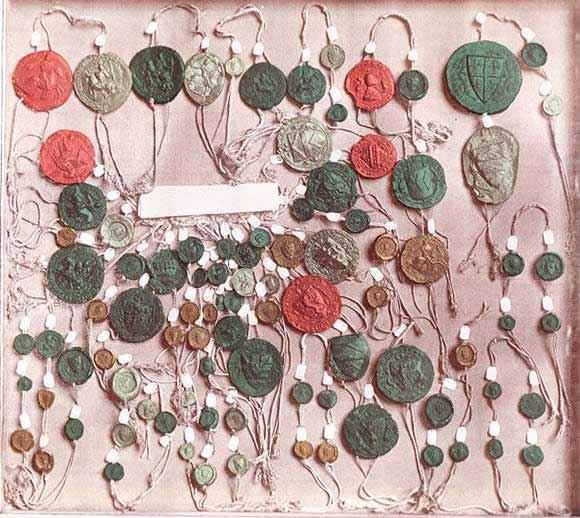‘We will advance knowledge through exemplary academic liaison and outstanding interdisciplinary research.’ – Archives Inspire
Henry of Lancaster’s seal (front) detached from Barons’ Letter B, 1301 (catalogue reference: E26 1 Cord E)
At The National Archives, we don’t just study what the documents housed here say. Technical analysis of the materials that make them also allows us to glimpse future possibilities for research.
Analysis of the will of William Shakespeare, for example, in preparation for the By Me William Shakespeare exhibition, has focused on both the ink and the paper. This may help divine different stages of the process of drafting and issuing individual records.
From an earlier period, parchment analysis may reveal not only the species of animal from which pages were made (often sheep or goat but occasionally deer and other animals) but also the diet and condition of the animal at slaughter; telling us more about medieval chanceries and the locations from which they got their equipment.
Work of this nature will improve our knowledge about the physical and ritual processes of authenticating individual authority and wishes in pre-modern England. It may also allow us to tap into research networks and other key material history projects currently underway, such as IMPRINT, which aims to analyse finger- and palm-prints on medieval seals to discover more about sealing practices.
Quite literally, we are only starting to scratch the surface of what the materials in our collection can tell us.
Deciphering wax seals
Perhaps the most challenging, yet rewarding, such research for me has been the Wax Seals Project. This combines the archivist’s descriptive skills and insight into provenance, symbolism and administrative practice, with methodologies employed by technical historians, analytical scientists and conservators
It is a collaboration between a medieval historian, a sigillographer (a seal expert – remember ‘King Ottokar’s Sceptre’?) and a heritage scientist. The aim is to discover more about seals and sealing practices – what the materials embodying sealed records in the medieval period can tell us about authenticating personal authority, status, ritual and administrative practice that the text cannot.
For decades, seals have been catalogued and described, their dimensions and colour noted. But other aspects, such as the wax and resin embodying the seal, or the cords or tags with which seals were attached to the documents, have taken a back seat. The Wax Seals Project has attempted to begin to address this imbalance.
Size and colour of seals
We have developed a new, more accurate methodology for measuring seals, which can prove crucial in differentiating between the Great Seal of England (used by the sovereign) and the seals of government departments.
Variations in colour, which is often a determinant of status and quality, can be achieved through different levels of pigmentation and wax preparation. Green could be produced without the addition of verdigris (the copper-containing pigment) by melting natural beeswax in a copper vessel, allowing it to oxidise. Practically, this implies seals could be produced quickly and cheaply – important for the itinerant medieval court.
Seals and their cords
Seal cords conceal much information about status and sealing practice. For example, on the 1301 letter of the barons of England to the Pope, the 180 seals are strung onto sixteen different types of cord, differentiated by colour and braiding technique. The methods by which cords are knotted to the parchment vary widely and suggest gradations of quality and status of the recipient.

Seals detached from Barons’ Letter Copy A, 1301 (catalogue reference: E/26 2)
The arrangement of seals on cords on documents with more than one seal may give important clues as to how documents were prepared for issue. Were they planned out carefully before drafting? Were clerks working in a haphazard manner with little direction? These are questions our analysis addresses.
Having joined The National Archives as a Medieval Records Specialist in the Advice and Records Knowledge Department in 2014, one of the most rewarding aspects of my role has been to work with people in fields outside my own. Collaboration with colleagues with often vastly different experience, skill-sets and, let’s face it, mind-sets, is fundamental to everything we do and ensures compliance with our primary legal and administrative functions. Interdisciplinarity is the royal road to scholarly innovation.
You can find out more of the finer details of the project in our podcast, ‘Materiality matters: new approaches to medieval wax seal studies‘.


[…] techadmin on March 22, 2016 Wax, cord and ink: the materiality of records2016-03-22T08:15:13+00:00 – Journals & Publications – No […]
Wonderful that at last this topic is being taken seriously at TNA, congratulations! It will be so exciting to follow the research and, let’s hope, develop a truly holistic understanding of our archival heritage by recognising that the what and how are as essential as the why such documents were produced. Do try to reach out to as many archives as possible across the UK as the vast majority of such documents are housed throughtout the nation and comparison is an essential strength in research. And remember our European network of archives and seals specialiasts – the production and trade in these materials stretches far from our shores.
Many thanks for the comment, Chris. You will be pleased to know that throughout the life of the project we have been liaising with partners in Germany, Latvia, Belgium and France. We have been in touch with Sigillvm and are hoping to take our work further in partnership with other institutions.
[…] Blog link here […]